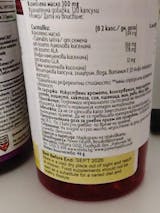- What is vitamin B deficiency?
- Main symptoms of vitamin B deficiency
- Neurological manifestations
- Hematological changes
- Specific symptoms according to type of vitamin B
- Thiamine (B1) deficiency
- Riboflavin (B2) deficiency
- Niacin (B3) deficiency
- Diagnostic approaches
- Risk factors and vulnerable groups
- Prevention and therapeutic approaches
- Conclusion
What is vitamin B deficiency?
The vitamin B complex includes eight essential water-soluble vitamins that play a key role in the metabolic processes of the human body. Thiamine (B1), riboflavin (B2), niacin (B3), pantothenic acid (B5), pyridoxine (B6), biotin (B7), folate (B9) and cobalamin (B12) work synergistically to maintain optimal functioning of the nervous system and energy metabolism.
Avitaminosis or hypovitaminosis of B complex vitamins can occur due to inadequate dietary intake, malabsorption, or increased metabolic demands. Modern lifestyles, characterized by processed foods and stress, predispose to the development of subclinical deficiencies that often remain undiagnosed.
Main symptoms of vitamin B deficiency
Neurological manifestations
Neuropathy is one of the most common manifestations of vitamin B deficiency symptoms. Peripheral polyneuropathy is characterized by paresthesias in the distal extremities - numbness, burning pain and decreased tactile sensitivity. Patients often describe a "socks and gloves" sensation that progresses proximally with prolonged deficiency.
Cognitive impairments include difficulty concentrating, amnestic episodes, and delayed psychomotor reactions. In severe cobalamin deficiency, subacute combined degeneration of the spinal cord with characteristic ataxia and spasticity may develop.
Hematological changes
Megaloblastic anemia is a pathognomonic finding in vitamin B12 and folate deficiency. Morphologically, macroovalocytes with increased mean cell volume (MCV >100 fL) and hypersegmented neutrophils are observed. Anisocytosis and poikilocytosis complete the hematological picture.
Thrombocytopenia and leukopenia may accompany the anemic syndrome, creating a pancytopenic picture in severe cases.
Specific symptoms according to type of vitamin B
Thiamine (B1) deficiency
Beriberi syndrome is the classic manifestation of thiamine deficiency. The dry form is characterized by polyneuropathy and muscle atrophy, while the wet form includes cardiomyopathy with high-output heart failure. Wernicke's encephalopathy is a neurological complication with the triad of confusion, ophthalmoplegia, and ataxia.
Riboflavin (B2) deficiency
Ariboflavinosis manifests with angular stomatitis, cheilosis and seborrheic dermatitis in the nasolabial folds. Corneal vascularization and photophobia are characteristic ophthalmological symptoms. Glossitis with a magenta-red hue completes the clinical picture.
Niacin (B3) deficiency
Pellagra is characterized by the four "Ds": dermatitis, diarrhea, dementia, and death. The skin lesions are photosensitive in nature with hyperpigmentation in exposed areas. Gastrointestinal symptoms include glossitis, diarrhea, and malabsorption.
It is important to note that vitamin B deficiency can manifest with a variety of nonspecific symptoms that can easily be attributed to other diseases. Early diagnosis is essential to prevent irreversible complications.
Diagnostic approaches
Laboratory diagnosis of vitamin B deficiency symptoms includes determination of serum levels of individual vitamins and their metabolites. Holotranscobalamin (active B12) provides more accurate information about functional status than total serum cobalamin.
Functional markers such as methylmalonic acid and homocysteine reflect tissue deficiency before serum changes appear. Elevation of these metabolites precedes clinical manifestations by months to years.
| Vitamin | Laboratory marker | Reference values |
|---|---|---|
| B1 (Thiamine) | Transketolase activity | >1.25 activation coefficient |
| B12 (Cobalamin) | Serum B12 | 200-900 pmol/L |
| Folate | Serum folate | >10 nmol/L |
Risk factors and vulnerable groups
Vegetarians and vegans are at high risk for developing cobalamin deficiency due to limited intake of animal products. The elderly are prone to vitamin B12 malabsorption due to achlorhydria and atrophic gastritis.
Chronic alcoholism impairs the absorption and metabolism of many B vitamins, especially thiamine and folate. Patients with inflammatory bowel disease are at increased risk of deficiencies due to malabsorption in the ileum.
- Patients with gastrectomy or bariatric surgery
- People taking metformin long-term
- Pregnant and lactating women with increased needs
- Patients with chronic kidney disease
- Individuals with autoimmune diseases
Prevention and therapeutic approaches
Prevention of vitamin B deficiency symptoms includes a balanced diet with sufficient intake of fortified grain products, animal proteins, and green leafy vegetables. Sublingual and intramuscular forms of cobalamin are preferred in cases of malabsorption.
Therapeutic doses vary according to the severity of the deficiency and clinical manifestations. In neurological symptoms, high doses are recommended for rapid replenishment of tissue stores. Combined B complex preparations provide synergistic action and prevent relative imbalances.
Monitoring of therapeutic response involves clinical observation and laboratory follow-up. Neurological symptoms improve within weeks to months, while hematological parameters normalize sooner.
Conclusion
Recognizing vitamin B deficiency symptoms requires a high degree of clinical suspicion and knowledge of the diverse manifestations. Early diagnosis and adequate therapy can prevent irreversible neurological complications and improve the quality of life of patients. An integrated approach, including dietary changes and targeted supplementation, ensures optimal therapeutic results.





















